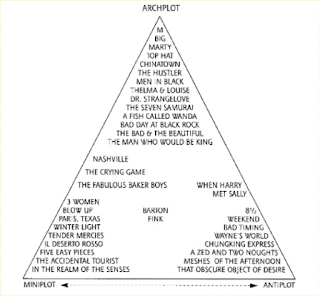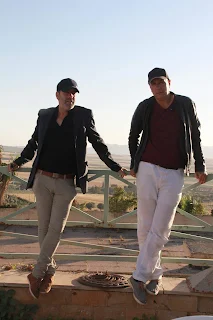Written by Sanaa El Alaoui
In art milieu, it is commonplace to be evoked by other artworks, provided that there is a subliminal stream that passes through and between artists, propelling them to be triggered by various new waves, theoretical trends, inventions and art forms. No matter rebellious or “avant-garde” these crafts can seem, by some means, they touch others artists, whether they are classic or contemporaries to react in certain ways. A perfect example of this claim is the translation or conversion of written forms into the visual language (film adaptation). Thus, if we often attribute painter’s instruments to brushes and colors, and writer’s instruments to pens and words, then it is inevitable that we will attribute cinema’s instruments to camera and images.
In his book, Astruc theorized the notion of “caméra-stylo” or “camera pen”, and this denotes the idea of storytelling via images and asserts that “direction is no longer a means of illustrating or presenting a scene, but a true act of writing” and that “the filmmaker/author writes with his camera as a writer writes with his pen” (22). This concept is an introductory ground to the so-called “Auteur theory” or “Film Authorship”. Such rebellious transgression arose along the “French New Wave” when it became explicit that there will be no radical separation between novel authorship and film authorship, and that both creators should be evaluated similarly. That is to say, the effectiveness of a film is mirrored in and evaluated from the directors’ performance, and that “there are no good and bad movies, only good and bad directors” (Truffaut). The reason why this topic is raised is that film adaptation is often referred to the concept of “horizons of expectation”, and that the silver screen, as a modern medium of expression, can hardly be consecrated to the level of books, following the claim that “literature profits from a double “priority”: (a) the general historical priority of literature to cinema, and (b) the specific priority of novels to their adaptations” (Stam 4).
The expression is a language in its own right; therefore, this language is conveyed through a multitude of mediums, ranging from cinema to craft, sculpture, composing, writing, dancing , singing … etc. For this reason, the topic in question is the whether the overarching message of the original work retains its substance or it evaporates throughout the process of words to images translation and its results in restricting the freedom of directors’ vision in expressing his work, following his bound to fidelity.
Edgar Alan Poe’s short story “The Cask of Amontillado” with its several film adaptations aptly embodies this issue. To begin with, it is noteworthy to put in mind the impossibility to answer to what extent the film adhered to a book, novel or a short story. The different medium to which the story is 2 exposed to has unavoidably its touch in conveying the meaning differently. The reason lies behind the fact that when readers are exposed to different items, this stimulates and enhances their comprehension of the story. Such items can be listed in music, camera movement, lighting, mise en scène, colors… etc.
These elements position the reader in a different world than the one they are exposed to while going through a written text. It is true that the extent of their imagination is wider when reading since they are not supplemented with any tools but their mere imagination, which explains their disappointment when they watch adapted films that did not live up to their “horizons of expectation”. However this does not mean that the filmmaker was not faithful enough to the original work, but in order to gain the title of an artist, one should keep in mind that acquiring a distinctive and special style is of crucial importance. “The Cast of Amontillado” is a quite interesting story, its poetic tone and ironic theme explain its alluring nature to worldwide filmmakers. Among these filmmakers, this essay examines Julián Franco Lorenzana’s film version. To start with, the symbolic richness of the original text is unquestionable. Every part of the story denotes meanings (explicit or implicit) that overlap with other meanings in the text. This can be the case for a film as well; the shots may overlap to indicate subliminal meanings which provoke the audience consciously and unconsciously. Apparently, this is quite identical to the notion of Vladimir Kulechov’s effect in cinema, as he implies that editing is our gate to understanding the gist with no need for dialogue or explicit thought, but merely with the juxtaposition of shots, and that “ the montage of shots is the construction of whole phrases” (350).
Lorenzana directed his film as per his stylistic vision, and this is quite obvious throughout his work. He started the film with a shot announcing a dark place where the audience is faced with a closed gate made of masonry (apparently built by Montresor). Parallelly, the camera takes us in a smooth manner with a zoom-in penetrating the closed gate; all accompanied by a slow and sad violin music that ends up with a fade-in triggered by a hollow sound, generated by the effect of plastering up the last stone into the stonework. Subsequently, with a fixed black shot, the director introduces the film title (The Cask of Amontillado) and the original author (Edgar Alan Poe). As the film progresses, the audience is slowly introduced to the setting of the story. The third shot begins with a voice-over of the text’s first lines joined by the sad music that begins again: “The thousands of injuries of Fortunato I had borne as I best could, but when he ventured upon insult I vowed revenge … “(line 1). Parallelly, a long shot takes us steadily throughout a room enlightened by dim flames of fire, where it reflects gothic shadows on a black mask and a trowel positioned on a table. As the recitation of the story carries on, the camera keeps moving on to position deeply the audience into the place (the room of Montresor in his Palace).
The camera stops at a high angle in the following shot, showing us a character (Montresor) writing some lines on paper (same lines that we hear equivalently in the voice-over). Above the desk, there is a glass of wine and some writing tools. The shot ends with a close-up onto Montresor’s hand, writing the last words with ink on paper enlightened by the same source of light: “ … he did not perceive that my smile was the at the thought of his immolation”
This description shows that symbolic meaning if it is denoted by words in the text, it is inevitably denoted by the gothic nature of the place (the dark gate/masonry in first shot), the trowel/mask on the table (the tools with which Montresor will arm himself to take vengeance), the fire that stirs the audience with a shrinking feeling and discomfort, and finally the wine on the table that represents the strongest weapon in the story. Cinema is a language of signs in its own right since each constituent is relevant to the story. Each object, each movement or camera angle denotes thoughts and provokes us unconsciously, and this is the beauty of film adaptation: re-telling a story in more than onne way with a new medium gives us a new reading every time. Generally, the ordinary means to read a novel is the narrator, this latter is indispensable and predominant.
He is the key to the story, and if there is no narrator, a reader is like a vehicle with no wheels. However, in film, the narrator is uncalled for, following the fact that he is replaced by other strong and alternative elements that stimulate our understanding and imagination. Even though in Lorenzana’s short film, we hear a voice-over of Montresor relating parts of the story sometimes, it is still superfluous. If we take the voice- over off, we can still understand the thoughts and feelings with the help of performance (e.g., facial expressions), camera movement, lighting, coloring, and even silence, for instance. The following shot takes us outside the room, where we explicitly see our main character, Montresor, walking in the narrow and dark streets of Italy where “it was about dusk”. As he walks through the street, the music of “the supreme madness of the carnival’’ rises as he approaches the place (line 11). The camera in a wide shot represents to the audience people dressed up madly and dancing widely in the dark streets and takes the viewers steadily to introduce Fortunato, who has dressed up accordingly as a jester. This might be exemplified ironically throughout the story. From one hand his name denotes the opposite of his fate and from the other hand, his outfit announces imbecility, and this is not matching his title of connoisseurship. A famous Chinese adage claims that “one picture is worth ten thousand words”.
On this ground, thoughts in the original text are expressed explicitly to understand the internal suffering of Montresor in one sentence: “…the thousand injuries of Fortunato I had borne … but when he ventured upon insult I vowed revenge…” However, in the film, this one sentence is demonstrated in one mere shot (the very first shot of the masonry). It denotes everything Montresor was feeling: his injuries (Metaphorically symbolized in the stones), his revenge (Beyond this gate is Fortunato’s catacomb) and his journey to revenge (the smooth penetration of camera throughout the closed gate). Another key element is the scene where Montresor and Fortunato stand next to the coat of arms. The beauty of this scene is announced in the shot composition and the characters’ position. From the left hand, Fortunato stands to gaze at the coat of arms, and from the right hand, Montresor holds a flambeau enlightening the entrance (A symbolic picture implying that Fortunato is gazing at his own place of burial, his fate). The flambeau illuminates the coat of arms positioned in the middle, which embodies “ a huge human foot d'Or, in a field azure; the foot crushes a serpent rampant whose fangs are imbedded in the heel” (line 60). As a result, we conclude that the indirect thought announces that Fortunato is faced to his own fate and that he will be crushed (as a serpent) by Montresor (the human foot d’Or) in a field azure (in the vaults).
Another ambiguous thought (which may not be denoted in the original text) is the position of the flambeau in the middle that gives a beautiful metaphor of the light (as Montresor’s knowledge) while holding it against the coat of arms (knowledge = revenge). We infer that there is an endeavor to tell the audience that the light is the guiding force of Montresor to seek his vengeance which is represented in “Nemo me impune lacessit” (line 62) and which implied that no one do bad to be and get not punished.
Consequently, thoughts in cinema may announce ambiguity that demands more mental effort for the audience to understand the message. In cinematography, one of the atypical and powerful tools is silence. Silence can be as dangerous as it can be peaceful and as effective as music, which explains its usage in my film genres especially the horror ones. As the film has a gothic influence, the audience can hear cautiously the echo of the unsteady treading of Fortunato followed by the sound of the jingling belt throughout the damp way, and this denotes a strong metaphor: as he they go deeper, the echo of the jingling belt and the footsteps enhance a feeling of suspense. However, this is not present in the text, the only tool presented in a written material is language, and the interpretation of this tool is dependent on the reader. Nevertheless, readers have the liberty to create their own film as per their vision.
Another way of approaching this issue is the extent of effort readers or viewers consume when exposed to these artistic trends. While reading, as discussed previously, the reader’s imagination is quite wide, provided that there is no supplementary tool that enhances their comprehension; therefore, there is no restrictions for them when it comes to creating their own film in their minds. Nevertheless, this does not mean that viewers may lack imagination. Contrarily, in films, fantasy and mental creation is as powerful as reading. When going through a text, we can readily feel and understand the characters’ emotions and their intentions; therefore, thoughts are more common in texts.
However, in films, we need more mental effort, following the lack of explicit thoughts. Even though actions may supplement our comprehension, they are still inadequate. Let’s say that a viewer hasn’t read the text, and he is exposed to this adapted film with no voice-over, he will surely need more mental effort to understand Montresor’s tendencies. It is noteworthy that it is not unfeasible to do so. However, it is only a matter of time and mental creativity to decode the message with certain kind of assistance, such as: objects, colors, lighting, subliminal actions, setting, camera position…. etc .
To conclude with, in his film, Lorenzana used a different chronological order than the original text. We afterward learned that the initial frame is itself the same last frame. The only difference is that the final frame ends with a high zoom-in into the coat of arms, which answers the question we formed initially: where are we? This gate is same one that announces Fortunate’s fate, and this is related to a cinematic logic where for a film to be successful, the first and last frames should be progressive, that is to say, some events should occur that would changes the last frame (e.g., accomplishment). In order words, Lorenzana began with a puzzling image where the audience needed to go through the whole film to decode it with the knowledge they gained in their mind to fill in the gap: what is that gate for and who is behind? Therefore, after watching the film, we can perceive that the substance of “The Cask of Amontillado” has been kept and that we eventually feel the same severity of Montresor’s suffering and his vengeance as we did while reading the original 5 work.
Not only this but also irony and symbols, as they were prevailing in the original text, they are domineering elements in this film as well, nevertheless they have been conveyed with different elements. As far as freedom of expression and its relation to restriction is concerned, Lorenzana was successful enough in recapturing the original work in some way that both maintain the gist of the source text and translate this substance as per his distinctive style. Hence, fidelity does not restrict the freedom of expression in a way that enchains the cinematic content. As a successful director, there are varieties of alternatives that allow expressing freely along with preserving the soul of the source text.
Filmmakers are in a constant development of their own style. Inspiration is of crucial importance in their lives, without it they cannot find their driving force. Artists breathe into other artistic works to generate reactive products. In other words, adapting a film is by any means a reaction or response in its own right. Therefore, it is worthy to say that the overarching message does not evaporate throughout the process of adaptation, as long as the director keeps its core. The core here is the subliminal stream that pulled the director in the first place, it was the chief reason why he wanted to adapt the film. However, since artists tools differ in respect to tendencies, personal interpretation, and stylistics vision. The question of fidelity will never evaporate following the fact that filmmakers cannot penetrate the minds of readers and answer every expectation their created in their minds. However, what we should perceive here is adaptation as some kind of artistic exchange or an intertextuality pursuit that gives a new reading every time. Therefore, the audience should widen their horizons and expect different readings every time they are exposed to adapted works.






























